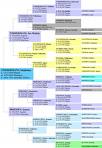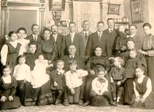|

Main Page
Hidden Gems
Sources of
Service
Articles
Tutorials
Application Tips
The Three P's
Chapter Registrars
Lineage Societies
Contact
Debbie
|
 |
 |
|
|
Workshop Outline |
|
|
|
|
|
 |
|
 |
|
Below is an outline for conducting a
DAR genealogy workshop. |
|
|
 |
| |
|
|
Genealogy Worksheet |
| |
|
| |
Before the workshop begins, encourage female attendees
interested in joining the DAR to complete as much as they know
about their parents, grandparents, and great-grandparents on
BOTH sides of their family on
the one-page
Genealogy Worksheet. Even if they only
have a
small amount of information, tell them to fill it in. Explain that you
will collect the worksheets at the end of the workshop, and
your DAR chapter will look for a Revolutionary War patriot
for them.
NOTE: This step is the most important part of
the workshop because it gives you the information you need
to turn an eligible workshop attendee into a DAR member.
After the workshop, make an extra copy of each of the
Genealogy Worksheets that you collected. The Chapter
Registrar should keep one set of the copies.
Distribute the extra copies to the person assisting you with
looking for a Revolutionary War patriot whether it is your
chapter lineage research committee or your state Area
Volunteer Genealogist. |
| |
|
|
What is the DAR? |
| |
|
| |
At the beginning of the workshop, introduce yourself and
provide some information about your chapter. Next, provide a
short
explanation
about the DAR. For example, the DAR was founded in
1890, and it is headquartered in Washington, DC. It is a non-profit,
non-political, women's service organization dedicated to
promoting patriotism, preserving American history, and
securing better education for our nation's children.
Mention the
eligibility requirements.
For instance, any woman age 18 years or older who can prove lineal,
blood line descent from someone who aided the Americans
during Revolutionary War is
eligible for membership. This part of the workshop should be no more than
2 or 3
minutes. |
| |
|
|
Finding a
Revolutionary War Patriot |
| |
|
| |
Next, provide a
very brief definition
of a Revolutionary War patriot in terms of the 3 types of
acceptable service which are
military, patriotic, and civil.
For example, state "In addition to military service, the DAR
accepts patriotic service which includes taking the oath of
allegiance, paying a supply tax, furnishing supplies, and
loaning money to the cause. Civil service, such as
serving as a town clerk, constable, surveyor of highways,
juror, or fence viewer is the third type of
acceptable service."
Discuss the time frame in which the service must have taken
place which is between 19 Apr 1775 (Battles of Lexington and
Concord) and 26 Nov 1783 (withdrawal of British troops from
New York).
Next, explain the processes and resources for finding a
Revolutionary War patriot in their family trees. Tell
them that you will be showing them two different strategies
for finding a Revolutionary War patriot "hidden" in their
family tree.
The best place to start is the
Public Member Trees Database on
Ancestry.com.
Although Ancestry.com is a subscription site, free access
may be available at your local Family History Center or
public library affiliate. Explain that they are
viewing a free tutorial called "Researching Your
Revolutionary War Patriot Ancestor." Provide attendees
with the website address to the tutorial in a handout. The address
is
http://www.learnwebskills.com/patriot
Use the script in the tutorial
to explain the first strategy for finding a Revolutionary
patriot which is working back in your direct lineage to
someone born between 1710 and 1765 who was living in 1775-1776. Once they find someone who fits that description
in their tree, they should check the DAR Ancestor Database
(I call it the
DAR Patriot Database
in the tutorial) to see
if that person is already an accepted Revolutionary War
patriot.
Next, discuss the second
strategy for finding a Revolutionary War patriot which uses
the
DAR Descendants Database.
Rather than starting with a potential Revolutionary War
patriot ancestor as is required when using the DAR
Ancestor/Patriot Database, the DAR Descendants Database
allows you to check the DAR database starting with your
great-grandparents. This can be the easiest and most
effective method for identifying the proven Revolutionary
War patriots in your lineage. The free video for DAR members only
called "How
to Find a Provable Patriot in 90 Minutes or Less"
will be helpful in understanding this second strategy.
Again, feel free to use the script in the tutorial for
discussing the Descendants Database. |
| |
|
|
Documenting the
Lineage |
| |
|
| |
Discuss the documents that DAR usually requires for the
first three to four generations in the lineage.
Explain that we need COPIES of these documents. They
need to keep the originals.
Generation 1 (applicant):
* her birth certificate (must list her
parents)
Generation 2 (parents):
* if one or both parents are LIVING, birth certificates
for one or both
* if one or both parents are DECEASED,
death certificates for one or both
* if parents' marriage
certificate can be obtained, please provide. If not,
don't worry about it.
Generation 3 (grandparents):
* if one or both are LIVING, birth certificates for one
or both
* if one or both are DECEASED, death certificates
for one or both
* if grandparents' marriage certificate
can be obtained, please provide. If not, don't worry
about it.
Generation 4 (great-grandparents):
* death certificates for both (if obtainable)
|
| |
|
| |
It is important that they know how to order the necessary
vital records for the recent generations. Thus, be
sure to discuss the CDC website for ordering
vital records as well as Deathindexes.com, and Find-A-Grave.
*
CDC Vital Records
*
Deathindexes.com
*
Find-A-Grave
For the purposes of a public genealogy workshop, this will
probably be sufficient to get the attendees started.
However, if you wish to discuss additional sites for
documenting the lineage, review the "Documenting
the Lineage" module for detailed instructions on
searching:
* the Family History
Library Catalog
* records on the
FamilySearch website
* county and town
histories
* the DAR GRC Index |
| |
|
|
Free Online Tutorial |
| |
|
| |
For more information, refer attendees to the free online tutorial "Researching
Your Revolutionary War Patriot Ancestor."
The address for the tutorial is:
http://www.learnwebskills.com/patriot |
| |
|
|
|
